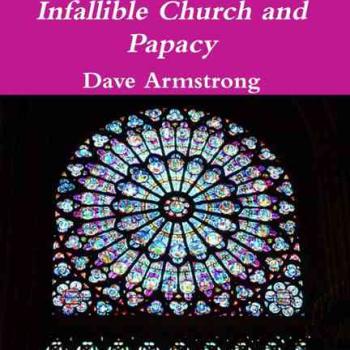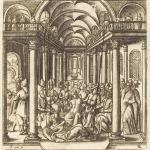Nicodemus & Baptism; Symbolic Baptism?; Universal Atonement; Relics; Hay’s Disbelief & Jn 6; Biblical Analogies to Transubstantiation; God & the Supernatural Eucharist; Eucharist & Dark Matter
The late Steve Hays (1959-2020) was a Calvinist (and anti-Catholic) apologist, who was very active on his blog, called Triablogue (now continued by Jason Engwer). His 695-page self-published book, Catholicism — a collection of articles from his site — has graciously been made available for free. On 9 September 2006, Hays was quite — almost extraordinarily — charitable towards me. He wrote then:
I don’t think I’ve ever accused him of being a traitor or apostate or infidel. . . . I have nothing to say, one way or the other, regarding his state of grace. But his sincerity is unquestionable. I also don’t dislike him. . . . I don’t think there’s anything malicious about Armstrong—unlike some people who come to mind. In addition, I don’t think I’ve ever said he was unintelligent. For the record, it’s obvious that Armstrong has a quick, nimble mind.
Two-and-a-half years later, starting in April 2009 and up through December 2011 (in the following quotations) his opinion radically changed, and he claimed that I have “an evil character,” am “actually evil,” “ego-maniac, narcissist,” “idolater,” “self-idolater,” “hack who pretends to be a professional apologist,” given to “chicanery,” one who doesn’t “do any real research,” “a stalwart enemy of the faith . . . no better than [the atheists] Richard Dawkins or Christopher Hitchens,” with an intent to “destroy faith in God’s word,” “schizophrenic,” “emotionally unhinged,” one who “doesn’t trust in the merit of Christ alone for salvation,” “has no peace of mind,” “a bipolar solipsist,” “split-personality,” and a “bad” man. He wasn’t one to mince words! See more gory details.
I feel no need whatsoever to reciprocate these silly and sinful insults. I just wanted the record to be known. I’ve always maintained that Hays was a very intelligent man, but habitually a sophist in methodology; sincere and well-meaning, but tragically and systematically wrong and misguided regarding Catholicism. That’s what I’m addressing, not the state of his heart and soul (let alone his eternal destiny). It’s a theological discussion. This is one of many planned critiques of his book (see my reasons why I decided to do this). Rather than list them all here, interested readers are directed to the “Steve Hays” section of my Anti-Catholicism web page, where they will all be listed. My Bible citations are from the RSV. Steve’s words will be in blue.
*****
[Chapter 11: Sacramentalism]
Born of water
One stock objection is that a baptismal referent is out of context. The institution of Christian baptism lay in the future. Nicodemus is reprimanded for failing to grasp what Jesus is alluding to. But if it refers to baptism, he’d be in no position to discern it. That information is not yet available. . . . for Christians who affirm the historicity of the account, the anachronism can’t be dismissed. [p. 576]
Jesus upbraids Nicodemus for failing to understand something which he ought to be able to grasp. If, however, Jesus is alluding to the Christian rite of baptism, that’s not something Nicodemus could be expected to know. [p. 584]
This is wrongheaded and shortsighted. Ellicott’s Commentary for English Readers stated about John 3:5:
Our task here is to ask what meaning the words were intended by the Speaker to convey to the hearer; and this seems not to admit of doubt. The baptism of proselytes was already present to the thought; the baptism of John had excited the attention of all Jerusalem, and the Sanhedrin had officially inquired into it. Jesus Himself had submitted to it, but “the Pharisees and lawyers” [Nicodemus was both] “rejected the counsel of God against themselves, being not baptised of him” [Lk 7:30]. The key to the present verse is found in the declaration of John, “I baptise with water . . . He baptiseth with the Holy Ghost” (John 1:26; John 1:33), and this key must have been then in the mind of Nicodemus. The message was, baptism with water; . . . by which the Gentile had been admitted as a new-born babe to Judaism, the rite representing the cleansing of the life from heathen pollutions and devotion to the service of the true God; baptism with water, which John had preached in his ministry of reformation (comp. Matthew 3:7), declaring a like cleansing as needed for Jew and Gentile, Pharisee and publican, as the gate to the kingdom of heaven, which was at hand; baptism with water, which demanded a public profession in the presence of witnesses, and an open loyalty to the new kingdom, not a visit by night, under the secrecy of darkness—this is the message of God to the teacher seeking admission to His kingdom. This he would understand. It would now be clear to him why John came baptising, and why Jews were themselves baptised confessing their sins. There is no further explanation of the “outward and visible sign,” but the teaching passes on to the “inward and spiritual grace,” the baptism of the Holy Ghost, the birth of the Spirit, which was the work of the Messiah Himself.
A twofold explanation of the “new birth,” so startling to Nicodemus. To a Jewish ecclesiastic, so familiar with the symbolical application of water, in every variety of way and form of expression, this language was fitted to show that the thing intended was no other than a thorough spiritual purification by the operation of the Holy Ghost. Indeed, element of water and operation of the Spirit are brought together in a glorious evangelical prediction of Ezekiel (Eze 36:25-27), which Nicodemus might have been reminded of had such spiritualities not been almost lost in the reigning formalism. Already had the symbol of water been embodied in an initiatory ordinance, in the baptism of the Jewish expectants of Messiah by the Baptist, . . .
Likewise, Cambridge Bible for Schools and Colleges:
Christ leaves the foolish question of Nicodemus to answer itself: He goes on to explain what is the real point, and what Nicodemus has not asked, the meaning of ‘from above:’ ‘of water and (of the) Spirit.’ The outward sign and inward grace of Christian baptism are here clearly given, and an unbiassed mind can scarcely avoid seeing this plain fact. This becomes still more clear when we compare John 1:26; John 1:33, where the Baptist declares ‘I baptize with water;’ the Messiah ‘baptizeth with the Holy Ghost.’ The Fathers, both Greek and Latin, thus interpret the passage with singular unanimity. Thus once more S. John assumes without stating the primary elements of Christianity. Baptism is assumed here as well known to his reader, as the Eucharist is assumed in chap. 6. To a well-instructed Christian there was no need to explain what was meant by being born of water and the Spirit. The words therefore had a threefold meaning, past, present, and future. In the past they looked back to the time when the Spirit moved upon the water causing the birth from above of Order and Beauty out of Chaos. In the present they pointed to the divinely ordained (John 1:33) baptism of John: and through it in the future to that higher rite, to which John himself bore testimony.
That water points definitely to the rite of baptism, and that with a twofold reference – to the past and to the future. Water naturally suggested to Nicodemus the baptism of John, which was then awakening such profound and general interest; and, with this, the symbolical purifications of the Jews, and the Old Testament use of washing as the figure of purifying from sin (Psalm 2:2, Psalm 2:7; Ezekiel 36:25; Zechariah 13:1). Jesus’ words opened to Nicodemus a new and more spiritual significance in both the ceremonial purifications and the baptism of John which the Pharisees had rejected (Luke 7:30). John’s rite had a real and legitimate relation to the kingdom of God which Nicodemus must accept.
Parsing “baptism”
Even if the NT attributes saving benefits to the sacraments, this doesn’t means the sacraments are in fact the source of saving benefits. For the NT would characterize the sacraments is precisely the same way even if that’s merely what they represent. For that’s the nature of symbolic representation. [p. 578]
I see. I wonder, then: if the NT language states that baptism saves, but Hays dismisses all that by saying it’s mere symbolic language, what would be an example of a statement about baptism that was undeniably not symbolic? I would love to hear the answer to this. Hays can’t answer, but other “anti-sacramentarians” can.
If the NT says that we are “saved” by baptism (Mk 16:16; Acts 2:40; Titus 3:5; 1 Pet 3:21) and “enter the kingdom of God” by baptism (Jn 3:5) and receive “forgiveness of [our] sins” and “the gift of the Holy Spirit” by virtue of baptism (Acts 2:38) and “wash away [our] sins” by baptism (Acts 22:16) and “may live a new life” because of it (Rom 6:4) and are “sanctified” and “justified” by baptism (1 Cor 6:11) and that baptism constitutes “the washing of regeneration” (Titus 3:5), I fail to see how Scripture could possibly be more clear than it already is regarding baptismal regeneration.
So I ask again: what would be an example of a Bible verse that would make the matter clear beyond all dispute? What more needs to be expressed that hasn’t already been?
Although the NT sometimes attributes saving benefits to the sacraments, it often promises the same saving benefits apart from the sacraments. For instance, it indexes such benefits to faith in Christ. That confirms the point that the ascription of saving benefits to the sacraments is symbolic. They illustrate divine grace. [p. 578]
This doesn’t logically follow. Hays is playing the “either/or” game and pretending that things are contradictory when they are not. The Bible teaches both things: we are saved by baptism and we are saved by faith in Christ. Four passages, with exceptional clearness, combine the two aspects:
Mark 16:16 “He who believes and is baptized will be saved; . . .
Romans 6:3-4 “Or don’t you know that all of us who were baptized into Christ Jesus were baptized into his death? We were therefore buried with him through baptism into death in order that, just as Christ was raised from the dead through the glory of the Father, we too may live a new life.”
1 Corinthians 6:11 “And such were some of you. But you were washed, you were sanctified, you were justified in the name of the Lord Jesus Christ and in the Spirit of our God.”
Titus 3:5 “He saved us, . . . in virtue of his own mercy, by the washing of regeneration and renewal in the Holy Spirit…”
***
[W]hat’s the value of unlimited atonement? If Jesus died for everyone, but some of the redeemed wind up in hell, then what difference
does it make? [p. 587]
The difference is that in universal atonement (the biblical view), God in His mercy gives everyone a chance to choose salvation. In limited atonement (the Calvinist unbiblical view), the poor souls for whom Christ did not die, have no chance whatsoever to be saved, and this is the case from all eternity, by God’s decree and express will. This is a blasphemous insult to God’s loving and merciful nature.
Relics
What do these examples have in common? Well, it’s not as if the mud and oil and water have any inherent therapeutic or medicinal value. And it’s not as if the mud and oil and water have any magical properties. [p. 592]
In and of themselves they do not, I agree. But the Bible teaches in many places that there are holy places and things, as well as holy people. This is the backdrop of relics.
God can assign a particular effect to a particular medium. [p. 592]
Yes He can. Now Hays is speaking much more sensibly.
God sometimes uses props for their symbolic value. If God authorizes the prop, then you’re entitled to use it. If it lacks authorization, then you have no right to use it. And even if we’re entitled to use it, we should place no faith in the prop. [p. 592]
Well, it so happens that God reveals in the Bible that several of these “props” connected with holy people or things were instrumental in healings; even to cause people to rise from the dead. Case closed. Hays disproved nothing regarding relics. He simply used his trademark sophistry to redefine a thing, “deCatholicize” it, and pretend that it isn’t what it is, as a result.
Apophatic sacramentalism
One reason I don’t believe in the real presence is because I couldn’t believe it even if I wanted to. And that’s because I don’t know what it means. And I’m not alone in that. No one knows what it means. [p. 597]
John 6:58, 60, 66 This is the bread which came down from heaven, not such as the fathers ate and died; he who eats this bread will live for ever.” . . . [60] Many of his disciples, when they heard it, said, “This is a hard saying; who can listen to it?” . . . [66] After this many of his disciples drew back and no longer went about with him.
Hays chose to believe that this teaching was too “hard” and refused to “listen to it” or accept it. Many millions in Protestant denominations sadly do the same thing. See:
Did Jesus’ “Hard Saying” (Jn 6) Make Disciples Leave? [3-5-19]
What does it mean to say a wafer or liquid (communion wine) is a human body? [p. 597]
What does it mean to say that God was “in” the pillar of cloud (Ex 13:21; 14:24; Num 12:5; 14:14) and the pillar of fire (Ex 13:21; 14:24; Num 14:14), or that He “appeared in . . . a pillar of cloud” (Deut 31:15), or that He “went before them” (Ex 13:21) in both? This was so profoundly realized by the Israelites (by revelation) that they worshiped God in the cloud (Ex 33:10). How can God somehow be “in a flame of fire” in the burning bush on Mt. Sinai (Ex 3:2)? The text even states that Moses saw God: “Moses hid his face, for he was afraid to look at God” (Ex 3:6). It’s a direct equation, just as we say that the consecrated host and wine are “God (Jesus).”
If this can be the case, then God can do the same in a wafer and wine; especially since He made it clear at the Last Supper and the John 6 discourse that this was the case: difficult as it was and is for us to comprehend. Many things in the Bible are difficult to grasp with natural, carnal reason alone, and require grace. How can we conceptualize a Being Who has always existed and Who can create the universe? It’s not like transubstantiation is so bizarre and weird — totally “off the charts” — that no one can possibly comprehend it. They choose not to, by creating an arbitrary double standard, in order to separate the “icky Catholic stuff” like this from other “strange, odd” miracles: like God in the pillar of fire and the pillar of cloud and the burning bush.
Is the body of Jesus miniaturized, so that you eat duplicate microscopic bodies of Jesus when you take communion? I have some idea of what that means. [p. 597]
How was God the Father (an immaterial spirit) in the microscopic water molecules of the pillar of cloud and in whatever fire is, on a miniature level, in the pillar of fire and burning bush, seeing that the Bible asserts that He was “in” all three? Why is it that Steve Hays had a need to figure everything out in terms of science and philosophy, as if there were no mysteries at all of faith and in Christianity? I guess he was a modern-day Doubting Thomas, Whom Jesus said was not as “blessed” as those who were obsessing over all the questions and demands that he had.
Christian theology allows for mystery, but it can’t be mystery through-and-through. [p. 597]
Ah, so Pope Steve Hays had to “veto” what was too mysterious to believe. He was the standard by which us poor folks of far less insight and intelligence could figure out exactly what in the Bible was worthy of belief, and what was ruled out as “mystery through-and-through.”
Problems with the real presence
If the bread or wine just is Jesus, then why doesn’t it look like Jesus? [p. 598]
If the burning bush just is “God” (Ex 3:6), then why doesn’t it look like God, or a Ghost (God the father being immaterial)?
The total lack of correspondence between the interpretation and empirical reality is, in itself, a reason to question or reject the interpretation. [p. 598]
Hays acts like a good hyper-rationalist, hard-nosed, agnostic-like skeptic, who thinks that the only reality is empirical. It’s not. If he were Moses on Mt. Sinai, it looks likely that he would have rejected God in the burning bush, contending that it wasn’t “empirical” enough. He would have demanded, like Thomas, to put his hand in the flame. After it was burned, it’s anyone’s guess whether he would believe God was talking to him. If he rejects one thing that he says he doesn’t understand (the Eucharist), why not another equally inexplicable divinely foreordained phenomenon?
If I held up a banana and said “This is Marilyn Monroe,” the fact that the claim defies manifest reality is good reason to dismiss the claim out of hand. [p. 598]
If I pointed to a bush that was burning but wasn’t consumed, that had a stentorian voice coming out of it, and said, “This is God,” the fact that the claim defies manifest reality is good reason to dismiss the claim out of hand.
There’s nothing in the text of Jn 6 to indicate that the Eucharist is a miracle–even assuming the Eucharistic interpretation. [p. 598]
Jesus says that the “bread of God” that “comes down from heaven” is His “flesh” which believers have to “eat” but that’s not miraculous? But if this was simply metaphorical for belief and faith, why does Jesus get into all these gory details about His flesh and blood? There was no need for that. If it were all a big symbolic thing, it seems to ne that John 6 should have been about half as long as it was.
Indeed, none of the accounts of the Last Supper in the four Gospels and 1 Cor 11 say the Eucharist is a miracle. [p. 598]
When Jesus said “this is my body,” it was required (all other exegetical factors considered) to interpret it literally and miraculously. If He had said that “this represents / symbolizes / stands for my body,” etc., then Hays might have a good point.
Gnostic communion
It seems to be bread and wine all the way down. According to our five unaided senses, it’s bread and wine. According to chemical analysis, it’s bread and wine. Put the wafer under an electronic microscope, and it seems to be just that. So the empirical properties are systematically misleading. Delusive. [p. 601]
I wrote about this sort of thing in my first book, A Biblical Defense of Catholicism (1996 / 2003):
Transubstantiation is predicated upon the distinction between two sorts of change: accidental change occurs when nonessential outward properties are transformed in some fashion. Thus, water can take on the properties of solidity (ice) and gas (steam), while remaining chemically the same. A substantial change, on the other hand, produces something else altogether. An example of this is the metabolism of food, which becomes part of our bodies as a result of chemical and biological processes initiated by digestion. In our everyday experience, a change of substance is always accompanied by a corresponding transition of accidents, or properties.
But in the Eucharist — a supernatural transformation — substantial change occurs without accidental alteration. Thus, the properties of bread and wine continue after consecration, but their essence and substance cease to exist, replaced by the substance of the true and actual Body and Blood of Christ. It is this disjunction from the natural laws of physics which causes many to stumble (see John 6:60-69). (pp. 80-81)
I also noted the example of the miracles of the loaves (Mt 14:19) as an example of the accidents changing (quantity) but the essence or substance (bread) remaining the same. But why would anyone think that both nature (water/ice/steam) and the miraculous (the loaves) can change the accidents and not the substance, but then turn around and claim that God can’t do the “opposite” miracle: change the substance but not the accidents? Neither Hays nor anyone else can make any argument — biblical or otherwise — suggesting that “God can’t do so-and-so!”, that is, unless it’s a logical impossibility (e.g., only one God exists and many gods exist both being true at the same time).
What is the real presence?
If God works with or works through a natural medium, then that imposes limitations on what he can do by that means. God can achieve an effect apart from natural means, but if he confines himself to a natural medium, then that restricts his field of action. [p. 602]
What makes Hays or anyone else think that God “confines himself to a natural medium”? Hays just pulled that out of a hat. God has not and does not do that, as He has shown in millions of miracles, answered prayer, indwelling us, the initial creation of the universe, etc. He pretends that God’s hands are “tied” in this way, but they’re not. This isn’t a logical impossibility.
How can one body be simultaneously present in separate places? [p. 603]
He can in a sacramental and miraculous sense. It’s a different sort of presence. Hays goes on to speculate in many related ways, which all add up to carnal thinking; thinking without the aid of the Holy Spirit. He insists on following this spiritual / theological “tunnel vision” and it gets him into all sorts of trouble and error. Transubstantiation, being an extraordinary and unique miracle, simply can’t be compared to or made more explicable by natural laws of science. One can attempt a partial analogy, as I did above, but at some point it ends and mystery and faith must take over. Far better was the view of St. John Henry Cardinal Newman:
People say that the doctrine of Transubstantiation is difficult to believe . . . It is difficult, impossible to imagine, I grant — but how is it difficult to believe? . . . For myself, I cannot indeed prove it, I cannot tell how it is; but I say, “Why should it not be? What’s to hinder it? What do I know of substance or matter? Just as much as the greatest philosophers, and that is nothing at all;” . . . And, in like manner: . . . the doctrine of the Trinity in Unity. What do I know of the Essence of the Divine Being? I know that my abstract idea of three is simply incompatible with my idea of one; but when I come to the question of concrete fact, I have no means of proving that there is not a sense in which one and three can equally be predicated of the Incommunicable God. (Apologia pro vita Sua, Garden City, New York: Doubleday Image, 1956 [orig. 1864], 318; part 7)
Newman’s comment was quite prophetic and ahead of its time. He noted how the “greatest philosophers” knew “nothing at all” about “substance or matter.” Scientists thought they had been finding out quite a bit about matter in the last 125 or so years, having traversed the “weird” theories of relativity and quantum mechanics, and having discovered all sorts of sub-atomic particles (quarks and neutrinos and so forth), and speculated about whether light was a particle or a wave.
But lo and behold, a completely new thing and field of study has now entered the picture of particle physics. Scientists are currently quite excited about the phenomena called dark energy and dark matter. The very notions have only made their appearance over the last 25-30 years or so. The term dark energy was coined by cosmologist Michael Turner in 1998. But — recent or not — it’s now widely accepted and represents the cutting edge and most fascinating field of study in cosmology and astronomy (superseding black holes and string theory). A NASA web page commented upon it as follows:
What Is Dark Energy? More is unknown than is known. We know how much dark energy there is because we know how it affects the universe’s expansion. Other than that, it is a complete mystery. But it is an important mystery. It turns out that roughly 68% of the universe is dark energy. Dark matter makes up about 27%. The rest – everything on Earth, everything ever observed with all of our instruments, all normal matter – adds up to less than 5% of the universe. Come to think of it, maybe it shouldn’t be called “normal” matter at all, since it is such a small fraction of the universe. . . .
[W]e still don’t know what it is like, what it interacts with, or why it exists. So the mystery continues.
So it’s considered to be 68% of the universe, yet it is almost a complete “mystery” and scientists are “clueless” about its origin. And “everything on Earth, everything ever observed with all of our instruments, all normal matter – adds up to less than 5% of the universe.” So if this is true, it turns out that science in all its glory (the atheist’s epistemological “god” and religion) has been dealing with a mere 1/20th of all that there is in the universe.
Likewise, dark matter (thought to make up 27% of the universe) is “completely invisible to light and other forms of electromagnetic radiation, making dark matter impossible to detect with current instruments” (National Geographic). Some scientists think dark energy is “a property of space.” Others think space is “full of temporary (‘virtual’) particles that continually form and then disappear.” Some appeal to Greek philosophy and call the mystery “quintessence.” How interesting. So we have this phenomenon, and it is serious science.
All of that is going on, and this is just natural science, before we get to an omnipotent God and miracles and biblical revelation. When all’s said and done even the most brilliant scientists know very little about matter, after all of our scientific experiments and theorizing for over 500 years. How is it then, that Steve Hays and many Protestant like him quibble about difficult things to understand with regard to transubstantiation? I’ll guarantee that it is less difficult to comprehend or conceptualize than quantum mechanics or dark energy and dark matter. Quantum mechanics alone is enough to boggle anyone’s mind (even, famously, Einstein’s). For example:
Perhaps the most famously weird feature of quantum mechanics is nonlocality: Measure one particle in an entangled pair whose partner is miles away, and the measurement seems to rip through the intervening space to instantaneously affect its partner. This “spooky action at a distance” (as Albert Einstein called it) has been the main focus of tests of quantum theory.
“Nonlocality is spectacular. I mean, it’s like magic,” said Adán Cabello, a physicist at the University of Seville in Spain.
But Cabello and others are interested in investigating a lesser-known but equally magical aspect of quantum mechanics: contextuality. Contextuality says that properties of particles, such as their position or polarization, exist only within the context of a measurement. Instead of thinking of particles’ properties as having fixed values, consider them more like words in language, whose meanings can change depending on the context . . . (Katie McCormick, “The Spooky Quantum Phenomenon You’ve Never Heard Of,” Quanta Magazine, 6-22-22)
Why couldn’t Steve Hays lay down his arms and bow to mystery and the supernatural in the case of the Holy Eucharist? I say it’s because he was a hyper-rationalist and modern-day Doubting Thomas. Maybe we should call him Skeptical Steve.
The true body and blood of Christ
The true body is empirically indetectable, whether by sight, taste, chemical analysis, &c. As such, the theory of the real presence requires God to create an illusion. . . . I’m not being facetious. I’m taking the implications of the real presence seriously. This is what an adherent is committed to. It has an illusory dimension. [p. 606]
Dark energy and dark matter are empirically indetectable, whether by sight, taste, chemical analysis, &c. As such, the theory of dark energy and dark matter (which are now thought to make up 95% of the universe) requires scientists to create an illusion. . . . I’m not being facetious. I’m taking the implications of dark energy and dark matter seriously. This is what an adherent is committed to. It has an illusory dimension.
***
Practical Matters: Perhaps some of my 4,300+ free online articles (the most comprehensive “one-stop” Catholic apologetics site) or fifty-one books have helped you (by God’s grace) to decide to become Catholic or to return to the Church, or better understand some doctrines and why we believe them.
Or you may believe my work is worthy to support for the purpose of apologetics and evangelism in general. If so, please seriously consider a much-needed financial contribution. I’m always in need of more funds: especially monthly support. “The laborer is worthy of his wages” (1 Tim 5:18, NKJV). 1 December 2021 was my 20th anniversary as a full-time Catholic apologist, and February 2022 marked the 25th anniversary of my blog.
PayPal donations are the easiest: just send to my email address: apologistdave@gmail.com. You’ll see the term “Catholic Used Book Service”, which is my old side-business. To learn about the different methods of contributing, including 100% tax deduction, etc., see my page: About Catholic Apologist Dave Armstrong / Donation Information. Thanks a million from the bottom of my heart!
***
Photo credit: The Whore of Babylon (workshop of Lucas Cranach): colorized illustration from Martin Luther’s 1534 translation of the Bible [public domain / Wikimedia Commons]
***
Summary: The late Steve Hays was a Calvinist and anti-Catholic writer and apologist. This is one of my many critiques of Hays’ “Catholicism”: a 695-page self-published volume.

















